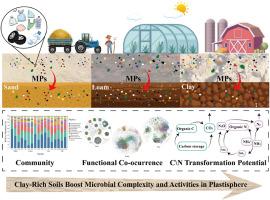Mechanisms of polyethylene microplastics on microbial community assembly and carbon-nitrogen transformation potentials in soils with different textures
IF 7.7
2区 环境科学与生态学
Q1 ENVIRONMENTAL SCIENCES
引用次数: 0
Abstract
Pollution caused by microplastics (MPs) is progressively altering soil health worldwide, with far-reaching consequences that may adversely affect ecosystems and public well-being. Using high-throughput sequencing of 16S rRNA, this research explores the impact of polyethylene (PE) MPs on the diversity and function of soil microbial communities, focusing on how these particles affect the movement of carbon and nitrogen across soils with different textures. The research analyzed soil samples of three different textures from 14 different regions. Results show that PE MPs reduced microbial richness in sand and clay soils by 17.33 % and 15.24 %, respectively, but increased richness in loam soils by 62.34 % (P < 0.01), mainly promoting the proliferation of bacteria such as Sphingomonas. Clay-plastic-associated soils exhibited 69,789 microbial network edges, significantly higher than sand (28,286) and loam (37,044), indicating enhanced functional connectivity, with more functionally important microorganisms present. Further analysis shows that the carbon sequestration capacity and nitrogen-transforming activity of plastic-associated soils increased with decreasing soil particle size. The structure and ecological balance of microbial populations linked to plastics in clay soils were predominantly governed by the organic matter present in the soil and the proportion of the C/N ratio. These results provide new insights into the effects of MPs on soil ecosystems and theoretical support for MPs pollution management and ecological restoration.

聚乙烯微塑料对不同质地土壤微生物群落聚集和碳氮转化潜力的影响机制
微塑料造成的污染正在逐渐改变世界范围内的土壤健康,可能对生态系统和公众福祉产生不利影响。本研究利用16S rRNA的高通量测序,探讨了聚乙烯MPs对土壤微生物群落多样性和功能的影响,重点研究了这些颗粒如何影响不同质地土壤中碳和氮的运动。该研究分析了来自14个不同地区的三种不同质地的土壤样本。结果表明,PE MPs分别使沙土和粘土土壤微生物丰富度降低17.33%和15.24%,而使壤土微生物丰富度增加62.34% (P < 0.01),主要促进鞘氨单胞菌等细菌的增殖。粘土-塑料相关土壤共有69,789个微生物网络边缘,显著高于砂(28,286个)和壤土(37,044个),表明功能连通性增强,存在更多功能重要的微生物。进一步分析表明,塑性伴生土壤的固碳能力和氮转化活性随着土壤粒径的减小而增强。粘土中与塑料相关的微生物种群结构和生态平衡主要受土壤有机质和碳氮比的支配。这些结果为研究多聚物对土壤生态系统的影响提供了新的见解,并为多聚物污染管理和生态修复提供了理论支持。
本文章由计算机程序翻译,如有差异,请以英文原文为准。
求助全文
约1分钟内获得全文
求助全文
来源期刊

Environmental Research
环境科学-公共卫生、环境卫生与职业卫生
CiteScore
12.60
自引率
8.40%
发文量
2480
审稿时长
4.7 months
期刊介绍:
The Environmental Research journal presents a broad range of interdisciplinary research, focused on addressing worldwide environmental concerns and featuring innovative findings. Our publication strives to explore relevant anthropogenic issues across various environmental sectors, showcasing practical applications in real-life settings.
 求助内容:
求助内容: 应助结果提醒方式:
应助结果提醒方式:


